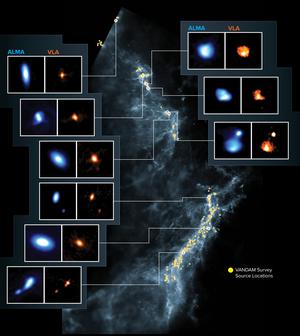Glossary term: 原恒星
Description: 原恒星是恒星形成过程的早期阶段。它是星际介质中巨大分子云收缩后形成的大量气体和尘埃。随着分子云的坍缩,引力势能转化为热能,使仍在形成中的原恒星升温。这一阶段可能需要 105 到 107 年,具体时间取决于恒星的质量,质量越大的恒星形成得越快。这个过程始于分子云核心密度的增加,终于前主序星的形成。质量与太阳相近的前主序星被称为金牛座T型恒星(T-Tauri)。一旦恒星内的氢聚变被点燃,它就开始产生能量,成为主序星。
Related Terms:
See this term in other languages
Term and definition status: The original definition of this term in English have been approved by a research astronomer and a teacher The translation of this term and its definition is still awaiting approval
The OAE Multilingual Glossary is a project of the IAU Office of Astronomy for Education (OAE) in collaboration with the IAU Office of Astronomy Outreach (OAO). The terms and definitions were chosen, written and reviewed by a collective effort from the OAE, the OAE Centers and Nodes, the OAE National Astronomy Education Coordinators (NAECs) and other volunteers. You can find a full list of credits here. All glossary terms and their definitions are released under a Creative Commons CC BY-4.0 license and should be credited to "IAU OAE".
If you notice a factual or translation error in this glossary term or definition then please get in touch.
Related Media
见证一颗恒星的诞生
Credit: ESO/ALMA (ESO/NAOJ/NRAO)/H.Arce. 致谢:Bo Reipurth credit link
License: CC-BY-3.0 Creative Commons Attribution 3.0 Unported icons
恒星诞生环境
Credit: ALMA (ESO/NAOJ/NRAO), J. Tobin; NRAO/AUI/NSF, S. Dagnello; Herschel/ESA credit link
License: CC-BY-3.0 Creative Commons Attribution 3.0 Unported icons










